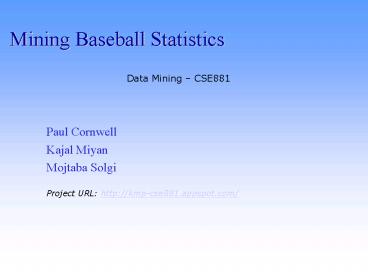Mining Baseball Statistics - PowerPoint PPT Presentation
1 / 13
Title:
Mining Baseball Statistics
Description:
Many statistics characterizing player performance are published yearly ... No apparent academic work on predicting MLB MVPs. PECOTA. Baseball Prospectus ... – PowerPoint PPT presentation
Number of Views:345
Avg rating:3.0/5.0
Title: Mining Baseball Statistics
1
Mining Baseball Statistics
Data Mining CSE881
Paul Cornwell Kajal Miyan Mojtaba Solgi Project
URL http//kmp-cse881.appspot.com/
2
Overview of Baseball
- Baseball is a team sport
- There are two major leagues AL (American), NL
(National) - Many statistics characterizing player performance
are published yearly - Each league names one player MVP (Most Valuable
Player) each year according to a vote - People place bets on who will be MVP
2
3
Overview
- Application (motivation)
- Can we predict who will be named MVP?
- Learn how to do data mining
- Learn about baseball
- Impress sabermetricians
- Baseball its not diseases, crime, or pollution
- Baseball statistics
- Main task predict MVPs for a given year
- Use SVM to rank players
3
4
Overview of Data and Mining
- Data 5 CSV files (Batting, Fielding, Master,
Awards, Salaries)? - Data Mining
- Ranking (similar to classification)?
- Anomaly detection (maybe)?
4
5
Methodology - Preprocessing
- Initial Data 90,000 rows in Batting table,
1871-2007 - One row one player/year/stint/team
- Cut to 1985-2007, 28,000 rows, b/c Salary begin,
rule changes - Perl script to merge tables by playerID/yearID/sti
nt - Batting?Fielding?Awards(MVP)?Salaries?Master
48 columns - 14 hours, but I got to relearn Perl!
- Discovered infeasible to use WEKA, need to use
SVM-Light - Reformatted from CSV to space-delimited SVM-Light
format - replace every value with attributevalue
- replace commas, spaces
- deleted 131 w/out fielding record (3-max 26, 21,
16 at-bats)? - create (binary) rank value based on MVP status
- replace all MM/DD/YYYY with YYYY
- insert qid column according to year/league (46
qids)? - ...
5
6
Methodology Data Mining
- Classification not apt to get good results, hence
ranking with? - SVM-Light (Cornell University)?
- Training generates a model which can rank input
- Training phase Leave one (year) out
- Testing Rank the players for that year
- Postprocessing
- SVM-Light returns only ranks of the players as
integers - match ranks with corresponding players
- Reformat data for visualization
- Ranked the data for each attribute
- Anomaly detection (in progress)
- KNN on 4 attributes (Gbat, R, HR, RBI)? for
players in gt 10 games - Compute z-scores for each attribute/year
- Rank players by distance from nearest neighbor
- Compare ranks in various attributes for detecting
anomalies
6
7
Methodology - Visualization
- Bar charts of top 20 ranked players for various
attributes - Python
- Google App Engine
- Google Charts tool
- U.S. map of player birthState density
7
8
Team Roles
- Roles of team members
- Planning - Everyone
- Preprocessing Paul Cornwell
- Data Mining Kajal Miyan
- Visualization Mojtaba Solgi
8
9
Related Work
- No apparent academic work on predicting MLB MVPs
- PECOTA
- Baseball Prospectus
- www.baseballprospectus.com/pecota/
- Baseball forecasting
- Makes statistical predictions about players
- No MVP prediction evident
- subscription service
- Books are available with baseball forecasts
- apparently for one year only
9
10
Experimental Setup
- Raw data downloaded from http//baseball1.com/cont
ent/view/58/82/ - Preprocessing done using Perl, Nano, Excel, OOo,
TextPad - Preprocessing yields a table with 28K rows and
45 columns - Experiments were conducted on a 2 GHz P4 machine
running Kubuntu 8.04 with 1GB RAM - Data Mining and postprocessing with SVM-Light,
Visual C, Matlab - Visualization done using Python, Google App
10
11
Experimental Evaluation
- Preliminary results
- SVM-Light trained on 1985-2006 data
- tested on 2007
- ranked actual MVPs 1 and 11 (out of 1242
players) (2nd NL, 2)? - (there is one MVP for each league each year AL,
NL)? - 2006 ranks 7, 16 (1371 players)
- 2005 ranks 1, 4 (1322 players)
- 2004 ranks 1, 3 (1342 players)
- 2003 ranks 3, 32 (1341 players)
- 2002 ranks 1, 11 (1316 players)
- Final evaluation (pending)?
- Leave-one-out
11
12
Visualization Demo
- http//kmp-cse881.appspot.com/
12
13
Conclusions
- MVP ranking was surprisingly successful
- Early results suggest that it is feasible to
predict MVPs with some accuracy - Lessons learned
- Data mining is hard work
- Baseball statistics are actually sort of
interesting - Future work
- Leave-one-out validation
- Incorporate team statistics in player evaluations
(expert advice)?
13































